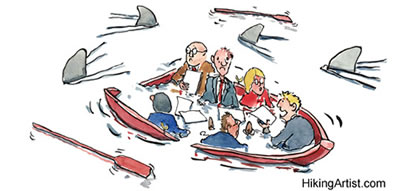Fighting Group-think with Descent
Blog contribution by Psyblog.· Why dissent is vital to effective decision-making.
In government, in corporate boardrooms, every day across the land people gather in groups to make decisions. More often than we would like these decisions turn out to be wrong, sometimes very badly wrong. Governments waste billions, corporations go bankrupt and people suffer. So why do groups sometimes make such awful decisions?
Group decision-making can go wrong in a number of predictable ways, but one of the most common is groupthink. Groupthink is a well-known psychological phenomenon, but less well-known are the techniques for fighting it.
Understanding how groupthink occurs and what can be done to fight it is vital for effective decision-making in groups, and consequently vital for well-run society and profitable businesses.
Groupthink
Groupthink emerges because groups are often very similar in background and values. Groups also usually like—or at least have a healthy respect for—each other. Because of this, when trying to make a decision, a consensus emerges and any evidence to the contrary is automatically rejected, ridiculed even. Individual members of the group don't want to rock the boat because it might damage personal relationships.
The groupthink pioneer was psychologist Irving Janis. He analysed the decisions made by three US presidents (Kennedy, Johnson and Nixon) to extend the war in Vietnam (Janis, 1982). Groupthink, he argued, explained why they had become locked in their course of action, unable to explore alternatives.
Subsequent psychological research has backed up Janis' arguments. Experiments show that people are quick to adopt the majority position and, crucially, they ignore all the potential alternatives and all the conflicting evidence (Nemeth & Kwan, 1987).
Manufacturing dissent
Fighting back against groupthink, Janis argued, is all about vigilant decision-making. What this means in practice is trying to make the group aware of problems with the consensus and offer alternatives. To do this someone in the group has to be critical. Encouraging critical thinking is not easy, but it is possible:
- Devil's advocate: someone in the group, but not usually the leader, is assigned the role of trying to spot holes in the decision-making process. This approach was tested by Hirt and Markman (1995) who encouraged experimental participants to generate multiple solutions. The results showed that these participants demonstrated lower susceptibility to group bias.
- The power of authentic dissent: unfortunately for the devil's advocate, they can easily be ignored because people don't take them seriously. Better, then, is someone who really believes in their criticisms. Nemeth et al. (2001) found that when compared with a devil's advocate, authentic dissenters were more likely to provide a greater quantity and quality of effective solutions.
- Nurturing authentic dissent: group leaders play a crucial role in encouraging (or crushing) dissent. Vinokur et al. (1985) analysed the decisions made by a panel investigating new medical technologies. The best outcomes were associated with a facilitative chairperson who encouraged participation from the group rather than one who was too directive.
These techniques for eradicating group-think, then, revolve around encouraging dissent. In the interests of making a good decision, someone has to be critical otherwise mistakes are easily made.
This may seem relatively obvious but there are all sorts of reasons why dissent is never expressed (from Nemeth & Goncalo, 2004):
- Organisations often recruit on the basis of who will 'fit in' and not 'rock the boat'. The stereotypical yes-man often emerges, perhaps unconsciously, as perfect for the job.
- Group cohesiveness is highly valued for productivity ('are you a team-player?'): groups who are always bickering are perceived as getting less work done.
- Disagreement and the expression of conflicting opinions makes people uncomfortable and they try to suppress it, partly because:
- Dissent is easily misinterpreted as disrespect or even a personal attack.
- Dissenters are often labelled as trouble-makers and targeted for either conversion to the consensus or outright expulsion from the group.
As a result dissenters in groups are likely to be an endangered species. To be effective dissenters must tread a fine line, avoiding pointless confrontation or personal attacks; instead presenting minority viewpoints in an even-handed, well-modulated and authentic fashion.
For their part the majority has to fight its instinct to crush dissenters and recognise the risk they are taking in being critical of the majority opinion. Although the majority consensus may well be right, it can be more secure in its decision if dissent is encouraged and all the options are explored.
What are you waiting for? It is time to disagree!








